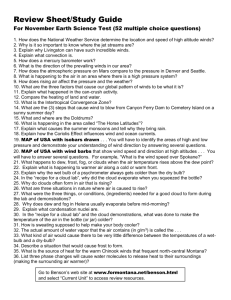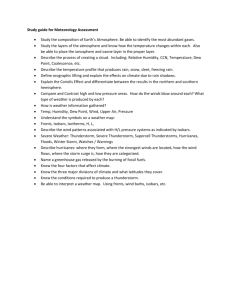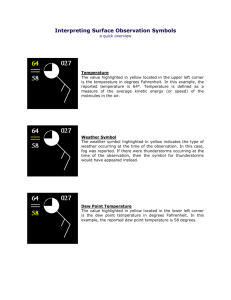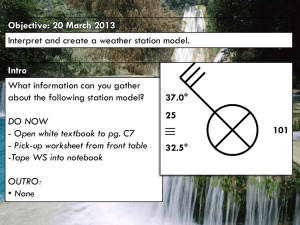Weather2
advertisement
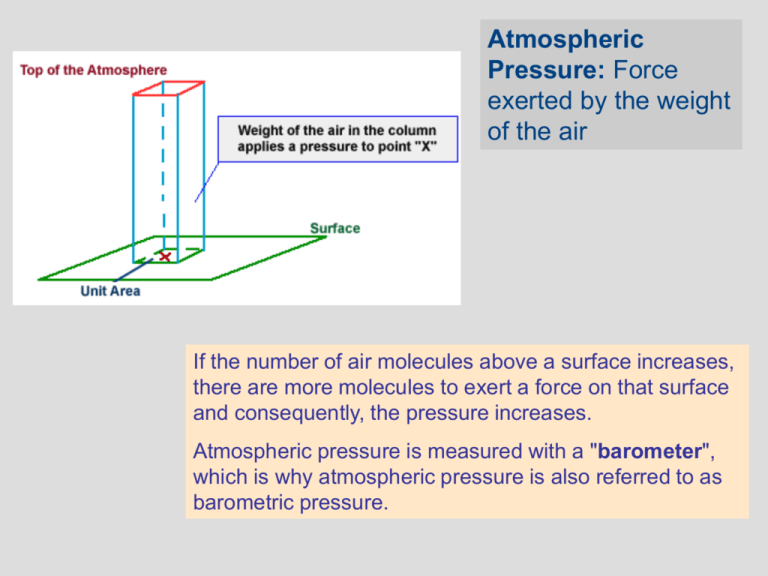
Atmospheric Pressure: Force exerted by the weight of the air If the number of air molecules above a surface increases, there are more molecules to exert a force on that surface and consequently, the pressure increases. Atmospheric pressure is measured with a "barometer", which is why atmospheric pressure is also referred to as barometric pressure. Location of high or low pressure centers provides information about: Wind direction Wind speed Cloud cover Precipitation We use metric unit for pressure called a millibar. the average pressure at sea level is 1013.25 millibars. Differences in pressure from one location to another causes: 1) Horizontal motions (wind) 2) Vertical motions (convection and subsidence) Location of high or low pressure centers provides information about: Wind direction Wind speed Cloud cover Precipitation The change in pressure measured across a given distance is called a "pressure gradient". The pressure gradient results in a net force that is directed from high to low pressure. In Northern Hemisphere Winds blow clockwise out of a high pressure center. Winds blow counterclockwise into a low pressure system Pressure Gradient Force directed from high to low pressure. High Pressure Centers A high pressure center is where the pressure has been measured to be the highest relative to its surroundings. Wind strength is proportional to the pressure differences. Strong gradients = strong winds Weak gradients = low wind speeds That means, moving in any direction away from the "High" will result in a decrease in pressure. A high pressure center is indicated on a weather map by a blue "H". Low Pressure Centers A low pressure center is where the pressure has been measured to be the lowest relative to its surroundings. That means, moving in any horizontal direction away from the "Low" will result in an increase in pressure. A low pressure center is indicated on a weather map by a red "L" and winds flow counterclockwise around a low in the northern hemisphere. As air flows out of a high pressure center, air from higher in the atmosphere sinks to replace it. This subsidence produces warming, dissipation of clouds and precipitation As air converges in a low pressure center, it rises and cools. If moist, cooling will cause moisture to condense and form clouds. Rising pressure readings: approach of a high pressure center and fair weather. Falling pressure readings: approach of a low pressure center and stormy weather Mountain barriers influence the development of high and low pressure centers Intense low or high pressure systems often occur on lee side of mtn. barriers Pressure decreases with height Falling pressure readings: approach of a low pressure center and stormy weather. Pressure gradient maps = semi-horizontal layer As surface of constant pressure descends, the pressure measurement rises Rule of Thumb 10 m height change = 1 mb Top of Space Needle to Base: 184 m --- 22 mb Fixed standard pressure level maps (rather than heights) Surface maps, at Earth surface 850 mb - available moisture for precipitation, ~1500m level 500mb - middle of atmosphere, troughs (lows) and ridges (highs), ~5500 m level 300 mb - jet streams at ~9100 m level [The average atmospheric pressure at sea level is ~1000mb] Mt. Everest: 8848 m w/ 314 mb pressure at summit 31% of atmosphere is present above this level. A line connecting points of equal pressure is called an isobar. At every point along a given isobar, the values of pressure are the same. The black numbers are station reports of sea-level pressure in millibars. The small blue numbers are contour labels, which identify the value of an isobar. These isobars have been generated from pressure observations. For example, pressure reports in Washington State are between 1014 mb and 1024 mb. An area of relatively high pressure is centered in western NE Nevada, while the pressure increases outward from this region. An area of lower pressure is located in western Alberta. Troughs: Elongated low pressure centers Ridges: Elongated high pressure centers. The black numbers are station reports of sea-level pressure in millibars. The small blue numbers are contour labels, which identify the value of an isobar. Wind Direction, Isobars and surface maps Ships on ocean example Small wave length waves or ripples are called shortwave troughs or ridges. 500 mb forecast for 1/21/1999. Troughs = red; solid lines = 500 mb height contours. High and low pressure centers and Wind direction Primary force = pressure gradient force (differences in pressure are proportional to pressure gradient Pressure gradient force is directed from high pressure to low pressure, crossing isobars at right angles. Secondary force = Coriolis force, apparent force from earth’s rotation Deflects winds at 90° to the right in direction of travel (N. hemisphere) Above 1000m, the balance of pessure forces cause winds to blow parallel to isobars or pressure height contours High and low pressure centers and Wind direction Path of air parcel starting out from rest in upper levels. Air flows towards low pressure Air turns to the right by CF When CF and PGF balance, winds blow parallel to the isobars. These winds are called geostrophic winds. Geostrophic wind blows parallel to the isobars because the Coriolis force and pressure gradient force are in balance. A. Aloft & B. at the ground Different wind directions and speeds relative to height contours (aloft) and pressure contours (ground). High and low pressure centers and Wind direction Near Ground surface Third force - frictional drag Slows wind down (fig 5.4b) Lower wind speeds weaken Coriolis force, causing winds to turn left, across isobars at angles 10° to 35°. Winds at ground blow more directly into low pressure centers. Monitor changes in wind direction, can see changes of pressure patterns and movement of high and low pressure centers Monitoring changes in wind direction. A. Winds aloft from west, low to the north B. Several hours later, winds aloft from the south, the low is now driven southward, west of observer. General Circulation Unequal heating between equator and pole causes circulation cells Location of cells correspond to alternating belts of high and low pressure regions. Cells also correspond to wind. Easterly winds from equator to 30° latitude (trade winds) and 60° to poles. Westerly winds from 30° to 60°. Jet Streams Strong air currents produced by pressure gradient between poles and equator. Location, strength and orientation vary with season and day to day. Summer and Winter positions Air Masses Regional scale volume of air with horizontal layers of uniform temperature and humidity. Form during episodes of high pressure Note location name = origin M = maritime C = continental T = tropical and P = polar Surface Maps Uses available surface data Shows: Temperature Weather Dew point temperature Cloud cover Pressure Wind direction and speed (wind barb) Surface Maps Use available surface data Shows: Temperature Weather Dew point temperature Cloud cover Pressure Wind direction and speed (wind barb) Observed Temperature station reporting symbol Observed Dew Point Temperature Dew Point and RH When the dew point temperature and air temperature are equal, the air is saturated. Dew point temperature is NEVER GREATER than the air temperature. If the air cools, moisture must be removed from the air. this is accomplished through condensation. Condensation is the formation of tiny water droplets that can lead to the development of fog, frost, clouds, or even precipitation. Relative Humidity can be inferred from dew point values. When air temperature and dew point temperatures are very close, the air has a high relative humidity. The opposite is true when there is a large difference between air and dew point temperatures, which indicates air with lower relative humidity. Dew Point and RH Dew points indicate the amount moisture in the air. The higher the dew points, the higher the moisture content of the air at a given temperature. Dew point temperature is defined as the temperature to which the air would have to cool (at constant pressure and constant water vapor content) in order to reach saturation. A state of saturation exists when the air is holding the maximum amount of water vapor possible at the existing temperature and pressure. Cloud Cover: Surface Maps Use available surface data Shows: Temperature Weather Dew point temperature Cloud cover Pressure Wind direction and speed (wind barb) The the amount of cloud cover observed at the time the observation is taken. In this case, broken clouds were reported. Sea Level Pressure: The last three digits of the sea level pressure reading in millibars (mb). Wind Barb: The wind barb. The wind barb indicates wind direction and wind speed. Surface Maps Use available surface data Shows: Temperature Weather Dew point temperature Cloud cover Pressure Wind direction and speed (wind barb)

